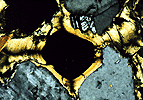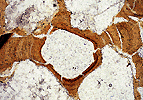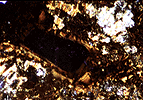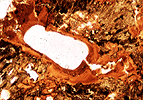Clay illuviation is the process that has been most exhaustively considered in micromorphological studies, and that is why it is going to be dealt with thoroughly here.
The clay illuviation process represents the mechanical migration
of clay from the surface horizons to the profile's deep horizons.
The water from atmospheric precipitations mobilises the clay from
the surface horizons and the suspensions infiltrate the soil through
the macrovoids. When these suspensions reach the deep horizons
where the soil is dry, the water of the suspensions is suctioned
by the microvoids of the surrounding areas and fine clay pellicles
are formed with their particles arranged in parallel to each other
and at the same time parallel to the voids' walls. These pellicles
that coat the walls of the macrovoids are called clay skins, or
cutans, or clay coatings, or argillans.
Similarly, when the suspensions reach the aggregates, as the water goes towards the interior of the edaphic aggregates, it deposits clay particles on their surface, also forming illuviation argillans that cover the aggregates.
The study of soil in the microscope (micromorphology) consists, in our opinion, of the most efficient technique to recognise illuvial clay, since clay coatings show the whole of their characteristics in thin sections, and after a thorough study of their nature, morphology, localisation and fabric, it is generally possible to differentiate them from the clay cutans with another type of origin, such as those from pressure.
Recognition of illuvial clay
Illuvial clay accumulations are characterised
by having their own characteristics, both with reference to their
optical properties and the way in which they are distributed in
the soil.
![]() Optical properties of illuvial clay coatings
Optical properties of illuvial clay coatings
With only the polarizer. Although in themselves they are colourless, clayey
masses generally have yellowish colours due to the Fe+++ they
incorporate.
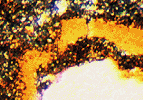
When the Fe content is very high their colours are reddish.
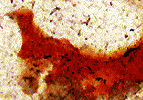
They only have greyish colours in hydromorphic soils (without incorporating Fe+++, or saturates with Fe++).
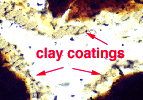
Polarizer and analyser. With crossed polarizer and analyser, the clayey masses should not show anisotropy, appearing with black or dark grey colours, since, although they are anisotropic crystals, due to their small size, the birefringence they produce is minimal. On the other hand, since the thickness of a microscopic preparation is about 30 microns, the light will pass through many particles when crossing a clayey mass and as they are randomly oriented the phase lags introduced in every crystallite will be compensated, finally cancelling the optical effects.
Due to their platy habit, the clay particles
tend to be oriented in parallel. The result is that when the polarised
light crosses them, the optical phenomena of every individual
particle is added to those of the adjacent particles, and the
oriented clayey domain behaves as if it were a single crystal,
showing different optical properties: interference colour,
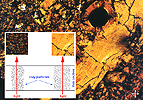
extinction phenomena
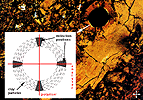
optical continuity, etc., that enable interpretations to be made on the environment in which the particles were distributed, as well as the way they accumulated.
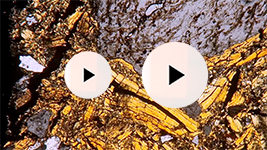
The extinction pattern is a measurement of
the degree of orientation:
